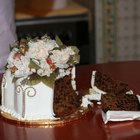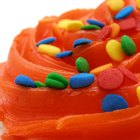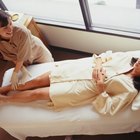
A thick, quality cake frosting will stay on a cake without melting and, in the case of piped decorations like flowers and borders, hold its shape over time. It can easily be altered, however, with liquids right in your kitchen to make a thinner glaze suitable for dipping anything from cookies to french toast sticks. Start your homemade dipping glaze with store-bought, canned frosting or homemade buttercream frosting. Thin the frosting a little at a time to find the best consistency.
Step 1
Place the frosting in a microwave-safe bowl and microwave it for about 10 to 20 seconds to melt the sugar and fat in the frosting. Stir the frosting well and microwave it in additional 10-second intervals, if needed, until it reaches a drizzling consistency.
Step 2
Stir in milk 1 tablespoon at a time to thin out the frosting. Use a wire whisk to thoroughly incorporate the milk with the frosting. Alternatively, use a liquid such as orange juice to thin the frosting while adding a hint of flavor.
Step 3
Scoop up a bit of the frosting in a spoon and tilt the spoon so the dipping glaze drizzles off the spoon. If it doesn't drizzle well or isn't thin enough, stir in more liquid until you reach the desired consistency.
Related Articles

How Long Do You Have to Beat Frosting ...

How Early Can You Make a Wedding Cake?

How to Make Icing With Very Few ...
How to Make White Drizzle Frosting

How to Heat Canned Icing

How to Make Drizzle Icing From Frosting ...
How to Make Ready Made Frosting Into a ...
Simple Chocolate Frosting Recipe

How to Get Tub Frosting to Harden

How to Make a White Decorator Icing

How to Remove Cake Frosting From Clothes

How to Make Lactose Free Icing

How to Make Sugaring Wax
How to Make Homemade Frosting With ...

How to Thicken Icing With Sugar

How to Get a Marriage Certificate Online
Easy Peanut Butter Frosting Recipe

How to Make Whipped Frosting for Cake ...

Can I Use Vanilla Buttercream Frosting ...

How to Make Almond Buttercream Frosting
References
Tips
- You might not need to add liquid when making the dipping glaze. If you can achieve the desired consistency after microwaving, for example, there's no need to proceed with the liquid. When the glaze is made from microwaving alone, it must be used while still warm because the fat solidifies as it cools. This is where the extra liquid is helpful because it thins the frosting permanently.
Writer Bio
A former cake decorator and competitive horticulturist, Amelia Allonsy is most at home in the kitchen or with her hands in the dirt. She received her Bachelor's degree from West Virginia University. Her work has been published in the San Francisco Chronicle and on other websites.
Photo Credits
Stockbyte/Stockbyte/Getty Images